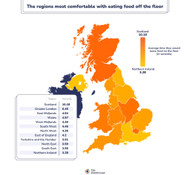Posted on Date 20th Dec 2023
The 3-5 Second Rule: Hygiene Survey
The 5 Second Rule
Its a popularly held concept that has divided opinions across the globe since its conception. As UK residents, we've all more-than-likely watched someone drop a tasty morsel of food onto the floor, hastily yell 5-second rule! and proceed to eat said food without a second thought.
The validity of the claim has been tried and tested, and whilst science suggests the information is false, research has confirmed that the less time food is spent on the floor, the less bacteria is likely to be picked up.
With such disparity around the subject, Tile Warehouse conducted a survey to find out just how often the UK public is abiding by the myth, how long is too long, which generations are the most likely to eat food that has fallen on the floor, and where in the UK people are likely to leave their food on the floor the longest.
How long will people leave food on the floor before they eat it?
Our results have found that the threat of contamination isnt stopping Brits from eating fallen food, with almost six in ten (59%) agreeing that they would still eat food that had touched the floor. Of those that agreed, one in six (16%) preferred to only leave food for 4-5 seconds, following in the steps of the favoured rule. The second-most-common result was 2-3 seconds (15%).
Throughout the study, just over 1% claimed that they would eat food left on the floor for up to 1 minute. Even more shockingly, 1 in 20 (5%) people claimed that they would eat the food no matter how long it had been left on the floor.
We found that nearly 2 in 5 people (38%) would eat food from their kitchen floor as they were confident it was clean, with 68% confirming that they clean their kitchen tiles regularly.
Although the majority of respondents were happy to eat food off the floor within 5 seconds, the opinion changed when it came to their children, with nearly 40% claiming they wouldnt let their kids do the same. Interestingly, the study also found that women (56%) were less likely to eat food off of the floor than men (61%).
Average time limit for each age group
It seems that generational divides also extend to the 5-second rule, with Millennials/Gen Y (aged 24-42) the most likely to leave food on the floor the longest. Members of this generation answered with 7 seconds as the average amount of time they would comfortably leave food on the floor before eating it.
Gen Z/iGen (aged 16-23) followed closely behind, on average adhering to the 5-second rule, whilst Gen X (aged 43-54) answered just below the average with 4 seconds.
Meanwhile, Traditionalist/Silent Generation (aged 74+) and Baby Boomers (aged 55-73) answered with the lowest amount of time on average with 3 seconds.
Average time by UK region
Taking a closer look at the regions in this study, we found that those in Scotland were likely to leave food on the floor for the longest amount of time with an average of 10 seconds. In second place was Greater London, with residents admitting they will leave their food on the floor for a maximum of 6 seconds at a time. Rounding out the Top 3 are the East Midlands, consisting of Derbyshire, Leicestershire, Lincolnshire, Northamptonshire, Nottinghamshire and Rutland who answered closest to the 5-second rule mark.
Wales, the West Midlands, South West, North West and East of England all answered similarly, with the average time ranging from 4.2 to 4.94 seconds.
Towards the lower end of the list, and averaging the lowest amount of seconds, are Yorkshire and the Humber, the North East, South East and Northern Ireland.
Which are the cleanest streets in the UK: city by city
Once wed gained an understanding of how people felt about eating food off of their own floors, we wanted to take the study a step further and see how people in different cities feel about eating food dropped on public flooring, from outdoor tiles to public walkways, and whether the same rules still applied.
The city most in agreement with abiding by the same rules and presumably with the cleanest streets was Bristol, with 44% of residents confirming that if they ate food off the floor at home, they would do the same in a public place. Following closely behind with 41% is Brighton, and Manchester sits in third with 38% of people agreeing.
In the middle of the list, we have Southampton, Plymouth, Glasgow and London, whose residents all answered similarly, with 33-34% confirming that they would also still eat food if they dropped it on public flooring. However, Glasgow residents came out on top when it came to the amount of time the food could be left on the floor before they decided not to eat it, with an average time of 15 seconds. Newcastle, Norwich and Belfast were the cities least likely to eat food dropped on a public floor.
Overall some 34% of all respondents would still eat food from the floor in a public place, which is representative of 18.6 million UK residents.
When asked about specific surfaces, nearly 40% of men claimed that they would eat food dropped on a public pavement. Surprisingly, over three in ten people surveyed said that it wouldnt matter what surface the food was dropped on it wouldnt deter them from eating it.
At Tile Warehouse, we want to ensure that our customers have everything they need on their tile buying journey to make an informed buying decision. So, whether its advice, knowledge or inspiration, we are with you every step of the way. Get in touch here.
Methodology
The research was conducted by Censuswide with 2,000 general consumers (nat rep) aged 18+ in May 2022. Censuswide abides by and employs members of the Market Research Society which are based on the ESOMAR principles.




